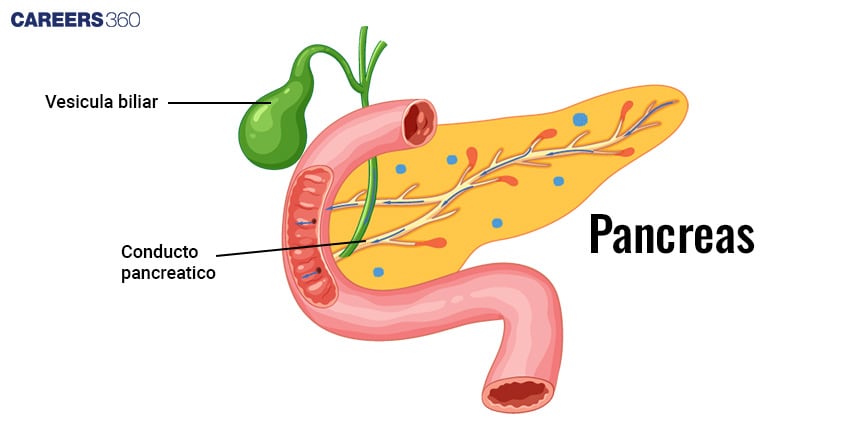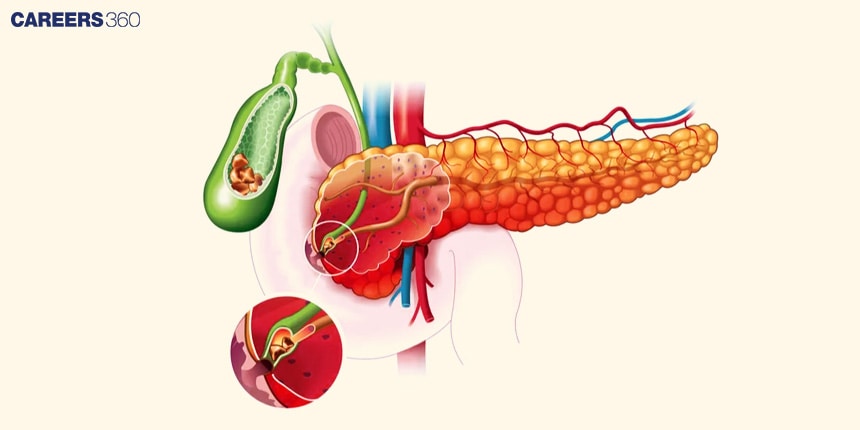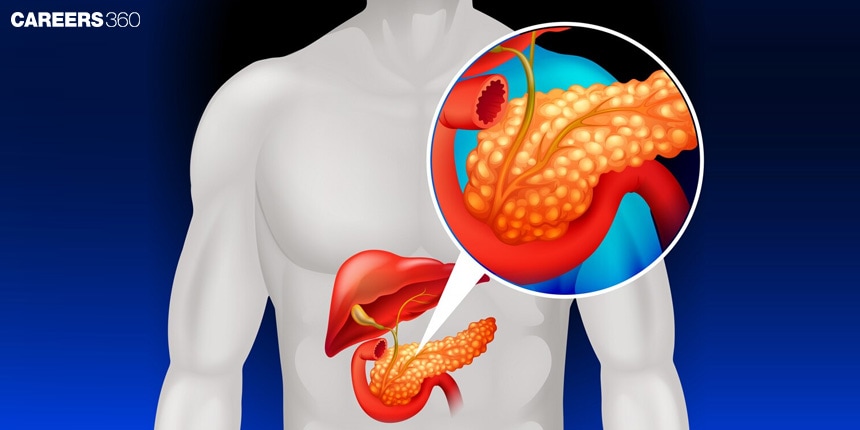Pancreas: Definition, Function, Diagram, Examples
What Is Pancreas?
The pancreas is an organ of the human body that plays important roles in both the digestive and the endocrine systems. The pancreas is an organ located behind the stomach whose functions are the manufacture of enzymes that help in digestion and hormones regulating the levels of sugar in the blood.
Structure Of The Pancreas:
Head: The head is the widest part of the pancreas and lies in the curve of the duodenum.
Body: The middle portion that extends behind the stomach
Tail: The narrow end that lies near the spleen Location: It is placed in the upper abdomen where it stretches horizontally across the body, nestled behind the stomach and in front of the spine.
Diagram: Pancreas

Functions Of The Pancreas
The pancreas performs two kinds of functions: exocrine and endocrine. These functions are very crucial for digestion and blood sugar homeostasis.
Exocrine Functions Of The Pancreas
The exocrine pancreas synthesizes enzymes for digestion, including amylases, lipases, and proteases. The produced enzymes are then secreted into the small intestine via the pancreatic duct, where they digest carbohydrates, fats, and proteins into small molecules that can be absorbed by the body. The process of production and secretion of enzymes is crucial for efficient digestion and food assimilation.
Endocrine Functions Of The Pancreas
The endocrine function is carried out by the Islets of Langerhans; it contains different types of cells. Alpha cells produce glucagon, increasing blood sugar levels. Beta cells produce insulin, which decreases blood sugar levels. Delta cells produce somatostatin, which acts to regulate the other two hormones.
These hormones work in harmony with each other to maintain blood sugar within a narrow range; this narrow range is physiologically vital to meet the energy needs of the body.
Pancreatic Ducts
The pancreatic ducts are a network of tubes Carroll 2014 that carry digestive enzymes from the pancreas into the small intestine. The main pancreatic duct joins the bile duct before it reaches the wall of the duodenum where digestive enzymes pass with bile to the duodenum for further digestion. Efficiently working ducts are what allow digestion and the absorption of nutrients to take place properly.
Diagram: Pancreatic Ducts

Disorders Of The Pancreas
The pancreas can be subject to several disorders, each affecting its functioning. Some common pancreatic disorders are as follows:
Pancreatitis
Pancreatitis is the inflammation of the pancreas. This may be acute or chronic and usually results from gallstones or excessive alcoholic intake. Severe abdominal pain, abdominal tenderness, nausea, and vomiting are typical symptoms. Treatment includes fasting with increased fluids, pain management, and surgery in some cases.
Pancreatic Cancer
It's a very dangerous disease with a high per cent of mortality. The risk factors revealed include smoking, obesity, and family history. The first symptoms do not manifest until the development of the disease is pretty advanced and may appear in the form of jaundice, weight loss, and abdominal pain. This dangerous disease can be treated both by surgical intervention and with the help of chemotherapy and radiation therapy.
Diabetes Mellitus
Diabetes mellitus is a metabolic disorder caused by a deficiency of the pancreas in producing or the inability of the body to use its produced insulin. There are two major types of diabetes:
Type 1 diabetes: The immune system mistakenly attacks the beta cells of the islets of Langerhans, which produces very little amount or no production of insulin.
Type 2 diabetes: The body becomes resistant to the action of insulin or is unable to produce enough insulin required.
NEET 2025: Mock Test Series | Syllabus | High Scoring Topics | PYQs
NEET Important PYQ's Subject wise: Physics | Chemistry | Biology
New: Meet Careers360 B.Tech/NEET Experts in your City | Book your Seat now
- What Is Pancreas?
- Structure Of The Pancreas:
- Functions Of The Pancreas
- Pancreatic Ducts
- Disorders Of The Pancreas
- Diagnostic Methods
- Treatment And Management
- Medical Management
- Role Of Pancreas In Digestion
- Recent Advances In Pancreas Research
- Recommended video on Pancreas

Management includes changes in lifestyle and, if required, medication along with insulin therapy.
Diagnostic Methods
The outcome of the treatment to a large extent depends upon a proper diagnosis of pancreatic conditions. The health condition and functions of the pancreas can be diagnosed in the following ways.
Imaging Tests
Ultrasounds: This is a non-invasive technique for generating the image of the picture and to determine any abnormalities present inside the organ.
Computed Tomography: High-resolution images are generated to assess pancreatic ducts and tissues.
Endoscopic Ultrasound: This is the use of endoscopy combined with ultrasound to produce details and images of tissues and take biopsies.
Blood Tests
Blood tests are conducted for the diagnosis of pancreatic disorders through the measurement of the levels of some enzymes and hormones.
Amylase and Lipase: Elevations in levels indicate pancreatitis.
Blood Glucose Levels: Useful in the diagnosis as well as in follow-up for the treatment of diabetes.
Tumour Markers: e.g. CA 19-9 in the diagnosis and follow-up of pancreatic cancer.
Treatment And Management
The type of treatment employed for disorders of the pancreas would be determined by the nature of the problem and its degree of severity.
Medical Management
Medications and other medical interventions are usually the first line of treatment for disorders of the pancreas.
Enzyme Supplements: Given to aid digestion in cases with exocrine pancreatic insufficiency.
Insulin Therapy: Required in diabetes mellitus.
Pain Management: Medications and nerve blocks in chronic pancreatitis.
Surgical Treatment: Surgery is resorted to when the condition is severe or life-threatening.
Pancreatic Resection: Partial removal of the pancreas is carried out in disorders like the treatment of cancer.
Whipple Procedure: It is a complex operative procedure to remove the head of the pancreas, the adjoining small intestine and a few other structures that lie near it.
Drainage Procedures: These are done to manage the complications like pseudocysts.
Role Of Pancreas In Digestion
The pancreas plays a very cooperative role with other digestive organ systems. It secretes enzymes into the small intestine that catalyze the digestion of various components of the meal. The pancreas further produces bicarbonate to neutralize stomach acid, providing an optimal environment for enzyme activity. That way, it ensures that all these processes go on properly in the digestion and absorption of nutrients.
Recent Advances In Pancreas Research
Research into health and diseases of the pancreas is an ongoing process. Some new advances include treatment for disorders of the pancreas, management of diabetes, and pancreatic regeneration. Genetic studies are spearheading innovations in newer knowledge about pancreatic cancer and give hope for better diagnosis and treatment options.
Conclusion
The pancreas is one of the important organs of the human body, undertaking two significant functions related to digestion and sugar levels in the blood. Such complex structure and functionality further increase its importance towards the maintenance of good health.
Recommended video on Pancreas
Frequently Asked Questions (FAQs)
The pancreas combines exocrine and endocrine functions. The exocrine function provides the digestive enzymes, while the endocrine function concerns itself with blood sugar level regulation by the secretion of hormones.
Digestive enzymes produced by the pancreas break down carbohydrates, proteins, and fats in the small intestine.
The pancreas produces insulin, glucagon, and somatostatin, essential in blood sugar homeostasis.
Keeping the pancreas healthy involves eating a balanced diet, regular exercise, avoiding excessive liquor consumption, and not smoking. Regular check-ups and monitoring of the symptoms associated with pancreatic disorders can detect them early and help in treatment.
Also Read
30 Nov'24 03:25 PM
26 Nov'24 05:38 PM
25 Nov'24 06:43 PM
25 Nov'24 05:45 PM
25 Nov'24 04:48 PM
25 Nov'24 03:52 PM
23 Nov'24 04:30 PM
23 Nov'24 10:03 AM